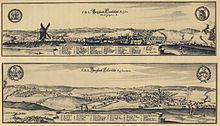Zellerfeld coin

The Zellerfeld Mint was a mint operated from 1601 to 1789 in what was then the mining town of Zellerfeld . Heinrich Julius , Duke of Brunswick-Wolfenbüttel , had the grubenhagen mint in Osterode closed. From 1597 he planned to move to Zellerfeld. After the Wolfenbüttel line of the Welfs died out in 1634, the coin went into the Communion-Harz , which was administered jointly.
Operation in the administrative building (1601–1672)
The Zellerfeld Mint experienced two operating periods. In the first period (1601–1672) the mint was housed in or in an annex to the office building of the mining office. The operation of a “printing unit” for roller embossing was planned from the start. However, the device delivered turned out to be unusable; it has therefore remained with hammer embossing . During this time the well-known Glockentaler and Hausknechtstaler (variant of the Wildemanntaler with spruce held across) were minted.
Operation in the new building (1674–1789)
The second operating period begins in 1673/74 with the construction of several new buildings on today's corner of Bornhardtstrasse and Marktstrasse. The massive annealing, melting and casting house still stands today. Large silver coins - even 1 ½ times thalers (1705) and three times loosers (1685 for the Lautenthalsglück mine ) - were minted using hammer minting . Despite the traditional minting technique, the coins belonged to the “best and most beautiful money in all of Germany”. A push mechanism was finally installed in 1742 and used to mint large silver. In 1753 the mint was given a laboratory for gold separation , which was privately owned by the respective mint master.
In the course of the dissolution of the communion resin, it was decided to abandon the coin. In 1789 operations were stopped and the inventory was gradually sold or used for other purposes. Up until the end the mint had no workers, only trained mint workers. In addition there was a wardein , a silver burner assistant, a coin guard and a coin boy.
Re-use of the building
The building ensemble of the new building from 1674 is popularly known as the "Alte Münze" or "Alte Zellerfelder Münze". After the end of the coinage, other departments of the mining authority, in particular the building yard, took over the buildings. Material for the pits in the area was partly stored, partly blacksmith and locksmith work was carried out. From 1821 an enamel factory used part of the site. In 1833 there was a major fire. In 1841 the enamel factory took over other rooms from the former mint; the building yard moved out. In 1852/53 new buildings were necessary after the Zellerfeld main mining factory had been set up here. The enamel factory ended in the 1860s. In the 1880s and 1890s, the mining factory initiated further renovations and extensions. In 1911 the trading post was relocated to Clausthal.
The property went to the administration of the province of Hanover , then to the Prussian justice administration. Residential use dominated until the Second World War . In 1941 the site went to the Clausthal-Zellerfeld municipality and was used as a warehouse and stable until the late 1970s. Despite a roof renovation in 1964, the buildings fell into disrepair. In 1978, after extensive renovations, an artisan farm with u. a. a glass blowing factory .
See also
Individual evidence
source
- Hans Burose (1984) On the history of the Zellerfeld coin. In: H. Burose, HE Kolb, WH Frank, E. Reiff (eds.) The Zellerfeld Mint - four contributions to the history of the old mint. Upper Harz History and Museum Association, Clausthal-Zellerfeld. Pp. 7-91
